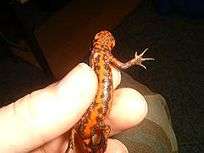Batrachochytrium salamandrivorans
| Batrachochytrium salamandrivorans | |
|---|---|
 | |
| Bsal infection in the skin of a fire salamander | |
| Scientific classification | |
| Kingdom: | Fungi |
| Division: | Chytridiomycota |
| Order: | Rhizophydiales |
| Family: | inc. sed. |
| Genus: | Batrachochytrium |
| Binomial name | |
| Batrachochytrium salamandrivorans Martel A., Blooi M., Bossuyt F., Pasmans F. (2013)[1] | |
Batrachochytrium salamandrivorans (Bsal) is a pathogenic chytrid fungus that infects salamanders and newts and emerged only recently as a potentially important threat to species in Europe and North America.
It was described in 2013 based on a strain collected from skin tissue of fire salamanders. The pathogen, unidentified up to then, had devastated fire salamander populations in the Netherlands. Molecular phylogenetics confirmed it as related to the well known chytrid B. dendrobatidis. Like this species, it causes chytridiomycosis which is manifested in skin lesions and is lethal for the salamanders.[1]
Another study estimated that this species had diverged from B. dendrobatidis in the Late Cretaceous or early Paleogene. It was shown that while frogs and caecilians were immune to B. salamandrivorans, it was lethal to many European and some North American salamanders. East Asian salamanders were susceptible but able to limit the infection. The fungus was also detected in a more-than-150-year-old museum specimen of the Japanese sword-tailed newt. This suggests it had originally emerged and co-evolved with salamanders in East Asia, forming its natural reservoir, and was introduced to Europe rather recently through the trade of species such as the fire belly newts as pets.[2]
The description of this pathogen and its aggressiveness raised concern in the scientific community and the public, fearing that it might be a rising threat to Western hemisphere salamanders.[3][4] On January 12, 2016, the U.S. government issued a directive that prohibited the importation of salamanders in order to reduce the threat posed by B. salamandrivorans.[5]
Etymology
Batrachochytrium is derived from the Greek words batrachos, “frog,” and chytra, “earthen pot” (describing the structure that contains unreleased zoospores); salamandrivorans is from the Greek salamandra, “salamander,” and Latin vorans, “eating,” which refers to extensive skin destruction and rapid death in infected salamanders. [6]
References
- 1 2 3 Martel, A.; Spitzen-van der Sluijs, A.; Blooi, M.; Bert, W.; Ducatelle, R.; Fisher, M. C.; Woeltjes, A.; Bosman, W.; Chiers, K.; Bossuyt, F.; Pasmans, F. (2013). "Batrachochytrium salamandrivorans sp. nov. causes lethal chytridiomycosis in amphibians". Proceedings of the National Academy of Sciences. 110 (38): 15325–15329. doi:10.1073/pnas.1307356110. PMC 3780879
 . PMID 24003137.
. PMID 24003137. 
- 1 2 3 Martel, A.; Blooi, M.; Adriaensen, C.; Van Rooij, P.; Beukema, W.; Fisher, M. C.; Farrer, R. A.; Schmidt, B. R.; Tobler, U.; Goka, K.; Lips, K. R.; Muletz, C.; Zamudio, K. R.; Bosch, J.; Lotters, S.; Wombwell, E.; Garner, T. W. J.; Cunningham, A. A.; Spitzen-van der Sluijs, A.; Salvidio, S.; Ducatelle, R.; Nishikawa, K.; Nguyen, T. T.; Kolby, J. E.; Van Bocxlaer, I.; Bossuyt, F.; Pasmans, F. (2014). "Recent introduction of a chytrid fungus endangers Western Palearctic salamanders". Science. 346 (6209): 630–631. doi:10.1126/science.1258268. PMID 25359973.
- ↑ Stokstad, E. (2014). "The coming salamander plague". Science. 346 (6209): 530–531. doi:10.1126/science.346.6209.530.
- ↑ Rhodi, Lee (2014-10-31). "Skin-eating fungus Batrachochytrium salamandrivorans threatens to wipe out salamanders worldwide". Tech Times. Retrieved 2015-06-05.
- ↑ "Listing Salamanders as Injurious Due to Risk of Salamander Chytrid Fungus". U.S. Fish and Wildlife Service. January 12, 2016.
- ↑ "Etymologia: Batrachochytrium salamandrivorans". citing public domain text from the CDC. Emerg Infect Dis. CDC. 22 (7): 1282. July 2016. doi:10.3201/eid2207.ET2207. Retrieved July 5, 2016.
.jpg)
